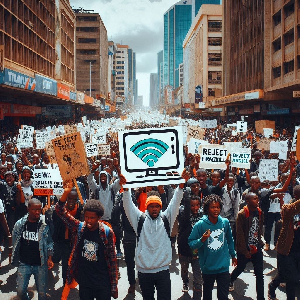In recent months, Kenya has witnessed a unique and powerful movement led by Generation Z (Gen Z) activists against the latest Finance Bill.
This protest, rooted in economic concerns, has demonstrated not only this generation's social and political understanding but also their adeptness at employing disruptive marketing strategies to amplify their cause.
This article delves into the strategic approach of the Kenyan Gen Z protesters and how their tactics mirror the principles of disruptive marketing, positioning them as both social change agents and savvy communicators.
The finance bill and its impact
The controversial Finance Bill proposed by the Kenyan government includes measures that would increase taxes and reduce subsidies, significantly affecting the cost of living.
The bill has sparked widespread discontent, particularly among the youth, who already face high unemployment rates and economic instability.
Gen Z, characterized by their digital and social awareness, has emerged as a vocal opponent of the bill.
Strategic approach of Gen Z protesters
Leveraging social media
Gen Z protesters have harnessed the power of social media platforms like YouTube, Twitter, Instagram, Whatsapp, and TikTok to spread their message.
Hashtags such as #RejectFinanceBill and #YouthForChange have trended, creating a virtual space for dialogue and mobilization.
These platforms serve as echo chambers, amplifying their voices beyond traditional media coverage.
Creating relatable content
Understanding the importance of relatability, the Gen Z activists have produced content that resonates with their peers.
Memes, infographics, and short videos highlight the bill's implications in a digestible format.
By using creative visuals, they make complex economic issues accessible and engaging.
Influencer collaboration
Recognizing the influence of social media personalities, the Gen Z protesters have collaborated with popular influencers to reach a broader audience.
These influencers, who command significant followings, help legitimize the movement and attract media attention. This tactic mirrors influencer marketing strategies used by brands to drive engagement and sales.
Grassroots mobilization
Despite their reliance on digital tools, the Gen Z protesters have not neglected traditional grassroots organizing.
They have held rallies, community meetings, and peaceful demonstrations, ensuring their message penetrates offline communities. This hybrid approach ensures comprehensive reach and impact.
Narrative framing
The protesters have adeptly framed their narrative to align with broader social justice themes.
By positioning the Finance Bill as not just an economic issue but a matter of youth rights and future prospects, they have broadened their appeal.
This strategic narrative framing galvanizes support from various demographics, including older generations sympathetic to the youth cause.
Leveraging global attention
By framing the protest within the larger context of global economic justice and youth activism, Kenyan Gen Z attracted international media attention.
This global perspective added pressure on the local government and showcased Kenya's youth as part of a larger global movement for economic justice.
The following are some of the international bodies and their influence during the protest:
•Human Rights Watch (HRW): HRW has been vocal in condemning the telecommunication restrictions imposed by the Kenyan government.
By documenting and reporting these actions, HRW has helped bring international attention to the protesters' plight and advocated for protecting their rights.
•Amnesty International: Amnesty International has provided critical support by mobilizing its global network to apply pressure on the Kenyan government.
Through petitions, social media campaigns, and direct advocacy, Amnesty has highlighted the injustices faced by the protesters and called for the restoration of unrestricted communication channels.
•Reporters Without Borders (RSF): RSF has focused on the freedom of information aspect of the protests.
By issuing statements and reports on the telecommunication restrictions, RSF has helped to underscore the importance of a free press and open communication in democratic societies, supporting the protesters' right to disseminate information.
•United Nations Human Rights Council (UNHRC): The UNHRC has played a diplomatic role, urging the Kenyan government to uphold international human rights standards.
Through official communications and public statements, the UNHRC has emphasized the need for Kenya to respect freedom of expression and assembly.
•Global Digital Rights Organizations: Organizations such as Access Now and the Electronic Frontier Foundation (EFF) have provided technical support and resources to help protesters bypass internet restrictions.
They have offered guidance on digital security, privacy, and the use of circumvention tools like VPNs and encrypted messaging apps.
Disruptive marketing principles at play
The Gen Z protest against Kenya's Finance Bill exemplifies several key principles of disruptive marketing:
Challenging the status quo
Disruptive marketing thrives on challenging existing norms and practices.
The Gen Z protesters question the government's fiscal policies and advocate for a more equitable economic approach, disrupting traditional political discourse.
Innovative engagement
Just as disruptive marketers use innovative strategies to captivate audiences, the Gen Z activists employed novel tactics like viral content and influencer partnerships to engage their peers.
This innovation ensures their message stands out in a crowded media landscape.
Customer-centric approach
In marketing, understanding and addressing customer pain points is crucial. Similarly, the Gen Z protesters focused on the immediate economic concerns of their peers, such as unemployment and cost of living, ensuring their activism was relevant and impactful.
Building communities
Disruptive brands often create strong communities around their products.
The Gen Z activists have built a robust online and offline community united by shared goals and values, fostering a sense of belonging and collective action.
Scalability
Effective disruptive marketing campaigns are scalable and adaptable. The protest movement has shown scalability by transitioning from online activism to physical demonstrations, demonstrating adaptability in various contexts and environments.
Real-time engagement:
Social media allowed for real-time feedback and engagement, creating a dynamic and interactive protest movement.
This immediacy is a hallmark of disruptive marketing, where consumer (or in this case, protester) engagement is paramount.
The impact and future implications
The protest has had significant impacts, including forcing the government to reconsider some of the proposed measures.
More importantly, it has set a precedent for how digital-native strategies can be effectively employed in political activism.
For businesses and marketers, this movement offers valuable lessons.
The power of community, the importance of clear and engaging messaging, and the ability to leverage digital tools for real-time engagement are all strategies that can be applied to disruptive marketing campaigns.
Kenya's Gen Z has not only demonstrated their political agency but has also provided a blueprint for modern activism.
By merging traditional protest tactics with innovative digital strategies, they have shown that the principles of disruptive marketing can transcend commercial use and drive meaningful social change.
Africa News of Saturday, 6 July 2024
Source: Shine Akiem Torsoo

















